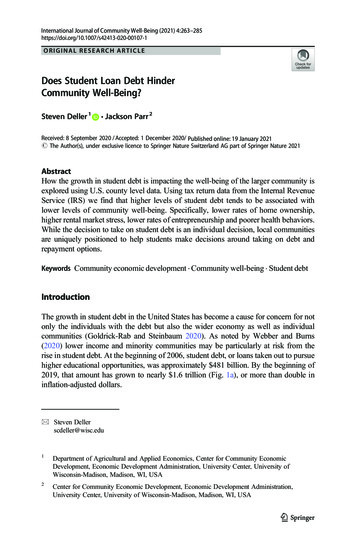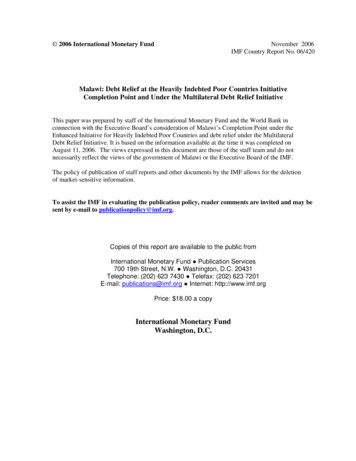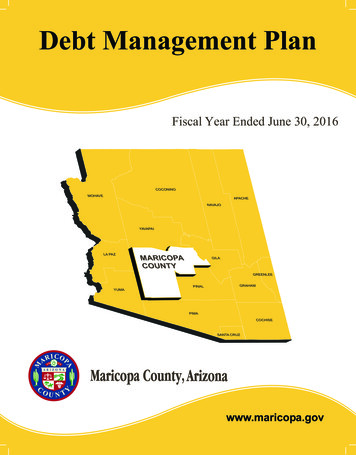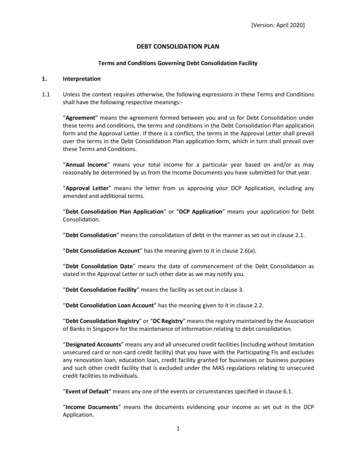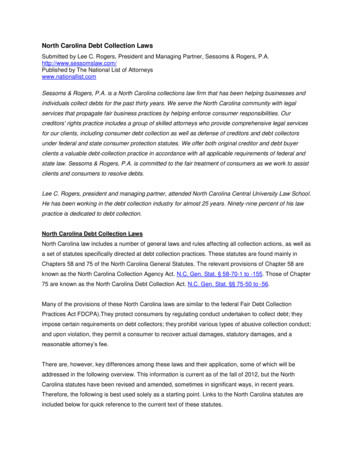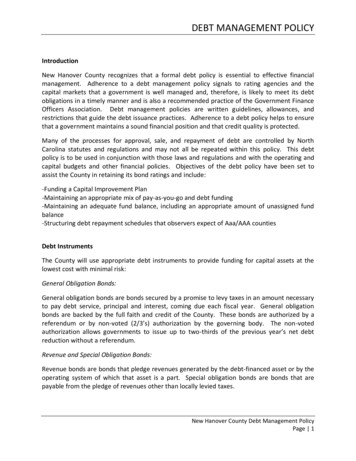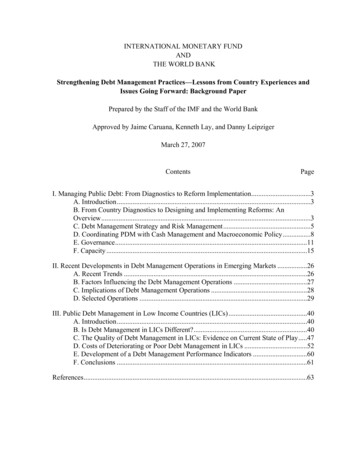
Transcription
INTERNATIONAL MONETARY FUNDANDTHE WORLD BANKStrengthening Debt Management Practices—Lessons from Country Experiences andIssues Going Forward: Background PaperPrepared by the Staff of the IMF and the World BankApproved by Jaime Caruana, Kenneth Lay, and Danny LeipzigerMarch 27, 2007ContentsPageI. Managing Public Debt: From Diagnostics to Reform Implementation.3A. Introduction.3B. From Country Diagnostics to Designing and Implementing Reforms: AnOverview.3C. Debt Management Strategy and Risk Management.5D. Coordinating PDM with Cash Management and Macroeconomic Policy.8E. Governance.11F. Capacity .15II. Recent Developments in Debt Management Operations in Emerging Markets .26A. Recent Trends .26B. Factors Influencing the Debt Management Operations .27C. Implications of Debt Management Operations .28D. Selected Operations .29III. Public Debt Management in Low Income Countries (LICs) .40A. Introduction.40B. Is Debt Management in LICs Different?.40C. The Quality of Debt Management in LICs: Evidence on Current State of Play.47D. Costs of Deteriorating or Poor Debt Management in LICs .52E. Development of a Debt Management Performance Indicators .60F. Conclusions .61References.63
2Tables1. Authorizations Required by Parliament and Other Institutions for Government Borrowingin the Pilot Countries .172. Distribution of Debt Management Functions in the Pilot Countries .183. Reporting Requirements Specified in the Legal Framework in the Pilot Countries .204. Debt-Recording Systems in the Pilot Countries .215. Recent Examples of World Bank Project Loans with a Debt Management Component .226. Selected External Debt Buy-Back Operations by EM Sovereigns: January-August 2006 .347. Evidence on Debt Management in Select HIPCs .478. Countries with Problems in Reporting Data .499. Results of Probit Regression Analysis: Quality of Debt Management and HIPCEligibility .5610. Indicative Costs of Passive Debt Management.58Figures1. Characteristics of Long-Term Public and Publicly Guaranteed External Debt in Middleand Low Income Countries.422. Size and Frequency of Negative Shocks in Real Export Prices Across Countries.433. Domestic Debt in LICs and Financial Market Development .454. NPV of Debt After HIPC Initiative, Additional Bilateral Debt Relief and MDRI.455. Debt Management Capacity in LICs .486. Arrears and Debt Management .537. Price and Cost of Public Domestic Debt in LICs .578. Concessional and Nonconcessional Debt Service In Four HIPCs.59Boxes1. Public Debt Legal Reform in Bulgaria and Nicaragua .122. Innovation in Mexican Debt Management—Sale of Debt Exchange Warrant .333. Debt Management in Kenya: Lessons from SIDA’s Technical Assistance Program.51AnnexesI. Governance.17
3I. MANAGING PUBLIC DEBT: FROM DIAGNOSTICS TO REFORM IMPLEMENTATIONA. Introduction1.The financial crises of the 1990s in developing countries drew attention to the qualityof public debt management (PDM) in developing countries, and to the role that deeper andmore efficient domestic debt markets can play in reducing financial vulnerability. In 2001,the World Bank and the IMF developed and disseminated sound practices in the areas ofPDM and developing the government domestic debt markets, particularly through theGuidelines for Public Debt Management (Guidelines) and the Handbook on DevelopingGovernment Bond Markets (Handbook).12.The process of moving from a set of general principles to a program of concretereforms and capacity building in a particular country is not straightforward.Recognizing this, a joint World Bank and IMF pilot program including 12 countries wasinitiated in 2002, with the objective of assisting countries in designing and implementingreforms with corresponding capacity building of the areas of PDM and domestic governmentdebt market development.2 Assessment reports in Bulgaria, Colombia, Costa Rica werecompleted in 2003, Croatia, Indonesia, Kenya, Lebanon, Nicaragua, Sri Lanka, Tunisia, andZambia in 2004, and Pakistan in 2005. This chapter summarizes the main insights drawnfrom this pilot program.B. From Country Diagnostics to Designing and Implementing Reforms: An Overview3.The pilot program adopted a comprehensive diagnostic approach to assessingcountry needs. The approach focused on both PDM and domestic government debt marketdevelopment and covered all areas that had potentially important policy implications.Moreover, it was designed to include two more stages—formulating, and implementing areform plan—in addition to the initial diagnostic stage.4.The outcome of the diagnostic reports in the 12 countries supported the premisethat a comprehensive diagnostic is useful and necessary. Several reasons were identified.1The Guidelines, published in March 2001, and subsequently revised in December 2003,and the Handbook,published in July 2001, were followed by the Accompanying Document to Guidelines for Public DebtManagement (2003), which contained 18 case studies written by country authorities on how they implementedpublic debt management based on sound principles.2The World Bank led this work. The 12 countries in the pilot program were Bulgaria, Colombia, Costa Rica,Croatia, Indonesia, Kenya, Lebanon, Nicaragua, Pakistan, Sri Lanka, Tunisia, and Zambia. Insights from thepilot program are published as Managing Public Debt: From Diagnostics to Reform Implementation andDeveloping the Domestic Government Debt Market: From Diagnostics to Reform Implementation, World Bank,2007. Follow-up has been undertaken in some countries, financed by project loans as outlined in Table 5.
4 A thorough understanding of the macroeconomic situation and the relationship with debtmanagement is crucial to ensure that a credible macroeconomic framework exists. Debtmanagement reforms have tended to be more effective where macroeconomic stabilityhad been achieved or was seen as progressing. The nature of the overall governance environment is critically important. The chances ofreforming PDM on its own are slim if there is significant high level corruption. The constraints imposed by the level of development of the domestic debt market have acrucial impact on the debt management strategy, including particularly the riskmanagement framework. There is a need to sequence steps in the right manner and bottlenecks to the process ofimplementing reform may escape a narrow approach. It is important to capture theinteraction between the building blocks of sound PDM, namely debt strategydevelopment, governance and institutional framework, and capacity issues.5.Most of the countries in the pilot program have developed reform plans of sometype. There are elements in designing reforms that seem to deliver success in terms ofmoving from the diagnostic stage to implementing reform. These include: Proper sequencing of reforms which reflect the realities on the ground. While somereforms may be second best solutions, they may be preferable to first best solutions thatare impractical to implement. Giving a clear project management focus to embedding medium-term institutionaldevelopment and capacity building. This provides a medium-term vision of the overallreform agenda, while taking into account immediate constraints, helping to keep in sightthe bigger picture and assisting governments in identifying opportunities forimplementing more ambitious reforms.6.The pilot experience suggests few generalizations can be made about thesequencing of PDM reforms. The basic building blocks, which necessarily have to comefirst, are building capacity in the back office and establishing reliable debt recording systems.These are required in order to ensure timely servicing of the debt, without having to rely onlenders’ notifications, and to produce accurate and frequent reporting. They are also at thecore of any development of a debt strategy. While most countries already had this in place,Kenya and Zambia did not.7.Beyond these steps, sequencing has been varied, reflecting different priorities,the political climate of the time, technical difficulty and capacity constraints. Therefore,an approach of “good fit,” rather than “best practice” characterizes the reform experience todate. For example, in Indonesia, Lebanon, and Tunisia, the judgment was that reforming thelegal framework was difficult at an early stage; however, in Bulgaria, Croatia, andNicaragua, legal reform was the first area where reform was implemented. Similarly, whileIndonesia and Zambia initially decided to delay organizational reform, Colombia, Costa
5Rica, Croatia, and Kenya viewed it as a necessary and feasible first step. Comprehensiveinstitutional and legal reforms have not been a prerequisite for developing an overall debtmanagement strategy across organizational boundaries. Indeed, as several pilot countrieshave demonstrated, significant progress can be made without this by forming working groupsor coordination committees (e.g., Costa Rica and Indonesia) and establishing islands ofexcellence with special budget and technical support to conduct analysis (e.g., Indonesia andLebanon).8.However, experience also suggests that a piecemeal approach has its risks andthat the longer term consequences should be carefully considered. For example,coordination committees can stop meeting with the departure of key persons(e.g., Colombia), capacity built can be lost as staff leave for the private sector (e.g., Kenya),secondary laws can add to already complicated and fragmented legal frameworks(e.g., Colombia and Indonesia), and the establishment of a new debt managementcoordination unit adds to the scattered organizational arrangements (e.g., Pakistan).9.Notwithstanding the need for tailoring reform to individual countrycircumstances, poor design in reform programs can be costly. For example, a publicfinancial management system with a debt management module was implemented in Croatiawithout prior study of the users’ functional requirements. Neither the vendor, nor thegovernment at the time, knew what a debt management system should look like, and haddifferent expectations from each other. The result was long delays, budgetary overruns, andincreasing operational risk arising from the aging of the old debt management system (whichdid not meet the evolving needs of the debt manager) and lack of system support.10.Elements that bring about sustained reform included: Ensuring ownership by the government and establishing an institutional environment thatcan make change happen. When local ownership and commitment to reform diminished,progress soon stopped. In most of the pilot countries an identifiable leader was key forreform to make progress. At the same time, the key leader was frequently seen as being atrisk of overloaded with competing reform priorities or day-to-day responsibilities. Integrating the debt management reform process into broader programs, such as publicsector or public financial management reforms. One benefit to this approach is that ithelps ensure project sustainability and continuity through financing, support by experts,and project supervision. Another benefit is that these broader programs addressfundamental problems such as civil service or public financial management weaknessesthat impact not just PDM but also other core government functions.C. Debt Management Strategy and Risk Management11.The composition of public debt, and therefore, the risks to which thegovernment was exposed, varied considerably across the 12 countries in the pilot
6program. While some caution needs to be applied when interpreting the data, on average,the countries had significant exposure to currency risk. The exposure represented asignificant risk to the governments’ finances, particularly for those that also had high publicdebt levels, such as Lebanon and Zambia, where foreign-currency debt amounted to 80percent and 160 percent of GDP, in 2004 and 2003, respectively. However, in countrieswhere the domestic government debt market was underdeveloped, external debt provided anopportunity to reduce rollover and interest-rate risks as it tended to be long-term andcontracted with fixed interest rates.3 A further consideration when interpreting currency riskis the source of external debt. Kenya, Nicaragua, Pakistan, Sri Lanka, and Zambia mainlyobtained funding from multilateral and bilateral concessional sources at very low cost andstable access compared to market sources. Croatia sourced mainly from the internationalcapital markets, while Bulgaria, Colombia, Costa Rica, Indonesia, Lebanon, and Tunisiacombined market and multilateral sources.12.The composition of the domestic debt portfolio varied, reflecting the varyingdegrees of development of the domestic government debt market, with Costa Rica,Kenya, Lebanon, Sri Lanka, Tunisia, and Zambia having a high concentration of short-termdebt, and Bulgaria, Colombia, Croatia, Indonesia, Nicaragua, and Pakistan achieving somelengthening of the maturity profile. As for the sources of domestic debt, Bulgaria and Croatiaborrowed exclusively through competitive auction systems, while Colombia, Costa Rica,Kenya, and Pakistan relied to varying extents on a combination of forced placements withpublic sector enterprises and banks, and market placements.413.Public debt managers in most pilot countries had a good understanding of themain risks of their debt portfolios and this shaped the management of governmentborrowing. While implicit strategies based on a general understanding of cost-risk tradeoffshave been largely reasonable, moving from a series of informal decisions to a formalstrategy—agreed at the ministerial level—was seen as important for several reasons. First,the lack of a formal debt management strategy increased the risk of resorting to expedientdecisions to cut costs over the short run, at the expense of greater long run risks (e.g., CostaRica and Sri Lanka). Second, the lack of a thorough analysis has meant that there was only apartial understanding of the trade-offs being made in terms of cost and risk, such as betweenforeign-currency debt (with very low interest rates and long maturities but containingcurrency risk), and local currency debt (which typically had shorter maturities and higherreal interest rates), e.g., Nicaragua, Sri Lanka, and Zambia. Third, the absence of an overall3For the purposes of this discussion, external debt is used to refer to debt contracted externally, i.e., in theinternational capital markets or from multilateral and bilateral creditors, rather than the residency of the creditor.4Forced placements typically help governments to reduce cost and to extend the average maturity of thedomestic debt in the short run, but are not conducive to a medium-term objective of developing the domesticgovernment debt market.
7strategy led to inconsistencies in the management of different parts of the debt portfolio. Forexample, the strategy to reduce interest rate risk in the market-sourced sub-portfolio byreducing floating rate debt conflicted with the strategy to increase floating rate debt in theofficial-source sub-portfolio in Indonesia. Similar inconsistencies were observed inColombia, Costa Rica, and Pakistan.514.Development of a formal debt management strategy is perhaps best viewed as aniterative process. As capacity is strengthened through time, and more analysis is undertaken,the quality of the debt strategy will improve: As a first step in improving the analysis of cost and risk, pilot countries have identifiedand described existing risks in the total debt portfolio in public reports (e.g., Bulgaria,Colombia, Tunisia, Sri Lanka, and Indonesia). In Costa Rica, this information has beenprovided for all public debt excluding that issued by the central bank, which will beadded as a next step. The authorities in Lebanon plan to produce a full set of riskindicators for its public debt, to supplement reporting on composition by currency. The next step is to conduct an analysis of cost and risk, including defining a base caseand alternative strategies and comparing these under a variety of market scenarios(exchange rates and interest rates). This has represented a significant challenge for thepilot countries, because of the technical skills required, but Bulgaria, Colombia, andIndonesia have been building capacity in the area, with Indonesia starting to apply thisfor the total debt portfolio. In Costa Rica, Tunisia, and Sri Lanka, such an analysis hasalso been planned.15.The debt management strategy document will reflect this iterative process. Thecontent and details in these documents can be improved over time. For example, the first debtmanagement strategy document published in Indonesia codified the existing processes thatdefined the composition of the debt and documented the rationale behind decisions. Thisallowed multiple players in the process to see the overall picture. It also clarified the natureof the constraints imposed by access to funding (including domestic government debt marketdevelopment), and macroeconomic management, and provided a reference point for furtheranalysis. Bulgaria’s strategy document includes strategic targets with ranges based on asimple analysis of cost and risk. The ranges allow for some variation in the targets due tointerest rate and exchange rate movements.65This should be distinguished from the management of sub-portfolios that is consistent with the cost and riskobjectives for the overall debt portfolio. In fact, a target for the sub-portfolio, such as targets for the domesticand foreign currency portfolios, helps better guide the portfolio manager with regard to their actions to managerisks in the respective markets.6Without ranges, debt managers would be forced to rebalance their portfolios very frequently for even thesmallest moves in markets. In countries where macroeconomic instability and volatilities in capital flows(continued )
816.When governments do not have sufficient information to establish targets orbenchmarks for the portfolio, establishing a general strategy or directives can be auseful first step towards strengthening the debt profile. Even for countries that facesignificant constraints on financing choices, these directives provide a framework to ensureborrowing is undertaken in a manner that is consistent with debt sustainability (e.g., settingminimum levels of concessionality, controlling the concentration of maturities).D. Coordinating PDM with Cash Management and Macroeconomic Policy17.Initial diagnostics showed that fiscal and budget planning was frequentlyundertaken with a one-year time horizon, and which reinforced a short-term approachto PDM. The absence of an explicit debt management strategy—which takes into accountthe management of risk—increased the likelihood that the borrowing program would bestructured to meet short-term budget needs. A number of pilot program countries had highpublic debt levels and interest expenses of up to 50 percent of government revenues at thetime of the assessment. Debt managers in Costa Rica, Lebanon, Pakistan, and Sri Lanka haveexperienced pressure to produce cost savings, irrespective of the impact on long-run risk.718.Recognizing the risks of setting a short timeframe for the fiscal policyframework in a short timeframe, some pilot countries have resorted to medium-termplanning. The budget projections in Bulgaria, Colombia, Kenya, Nicaragua, and Sri Lankawere on a three-year rolling basis and Tunisia’s was determined within the framework of afive-year plan. This has helped debt managers to focus on the medium term when developingtheir borrowing plans. Pakistan (2005) enacted fiscal responsibility legislation and will beginmulti-year budgeting.19.Improving the quality of PDM cannot, however, be a substitute for sound fiscalpolicy. Fiscal policy is the main determinant of the requirement to borrow, and therefore, theprimary influence on the stock over time. It was precisely those countries where governmentswere not able to control debt dynamics, and where actions toward fiscal consolidationweakened, that progress in debt management reform was slowest. For example, in Sri Lanka,a change in government in 2004 slowed down the momentum for reforms initiated by theprevious government. In Lebanon, continued internal tensions and fractious politicsprevented much of the Paris II policy agenda from being implemented, so debt levels did notdecline. In Nicaragua, debt forgiveness was not followed through with fiscal consolidation,as this was sent off track following a sharp rise in political tensions from early 2004. Thevolatilities are a major factor, or where strategy development is still at its incipient stage, “soft” targets, withbroader ranges than the Bulgarian case, may be more appropriate than narrower ranges.7In the absence of well-designed governance arrangements for monetary policy, similar pressure may also beplaced on the monetary authorities, to the detriment of their price stability objectives.
9decision not to take the fiscal responsibility legislation forward was based on the authorities’assessment that given such a political environment, it would not have achieved the desiredresult.20.Although fiscal sustainability analysis is the responsibility of fiscal policyadvisors, debt managers are able to provide a richer understanding of how changes infinancial variables could affect government finances. However, debt manager’s input tofiscal sustainability analysis in the pilot countries has been minimal.21.The group of pilot countries that have been able to stabilize or reduce their debtlevels achieved this through sustained fiscal consolidation and a period of strongeconomic growth. In order to support these outcomes and to reduce the vulnerability toshocks, actions to strengthen PDM have been a priority in Bulgaria, Indonesia, and Tunisia.These countries illustrate how positive debt dynamics can be generated by a well coordinatedimplementation of sound fiscal, monetary and debt management policies.22.Coordination between PDM and monetary policy is particularly important incountries with less developed domestic government debt markets. In Costa Rica, Kenya,Lebanon, Indonesia, and Nicaragua, the main instrument of monetary policy to mop upexcess liquidity was issuing debt in the primary market; that is, using the same instrument asthe public debt manager. The scale of these operations was large in Costa Rica andNicaragua where the governments had not fully financed their past deficits, forcing centralbanks to issue considerable volumes of their own debt and weakening their capital structure.While both the ministry of finance and the central bank in these countries agree on the needfor a long-term resolution of the recapitalization of the central bank, such an action was notpolitically feasible in the short run. In the interim, improved coordination in developing andimplementing the debt management strategy, combined with building capacity at the ministryof finance are being implemented.23.Policy conflict between debt management and monetary policy, or the potentialfor such conflict, was seen to occur when the central bank takes a leading role inmanaging domestic debt (e.g., Lebanon, Kenya, Pakistan, Sri Lanka, and Zambia). In thesecircumstances there may be pressure on the central bank to reduce debt servicing costs forthe government by providing direct financing, or by maintaining interest rates at levels lowerthan desirable for price stability. Often, the central banks performed this role throughnecessity, as capacity was limited in finance ministries and efforts to change this couldhappen only slowly, and over a period of time. Short-term measures include agencyagreements between central banks and ministries of finance that clarify decision-makingrules with regard to domestic debt management and greater transparency around theimplementation of monetary policy.24.In most pilot counties, monetary financing of the government deficit wasprohibited. Some leeway for central bank financing was allowed in Kenya and Zambia, and,
10in Pakistan, there was no legal restriction against this. The scope for monetary financingallows the ministry of finance to withdraw from the market completely, or to reject low bidsin auctions. It also has implications for the credibility of monetary policy, as marketparticipants may perceive a conflict of interest in the central bank’s actions, and a desire tolimit public debt servicing costs. It may also hinder the development of the money and bondmarkets.25.Poor credibility of monetary policy is a contributing factor to a high degree ofdollarization, as seen in Costa Rica, Nicaragua, and Lebanon, where citizens prefer to holdmuch of their savings in foreign currency. This in turn has implications for PDM anddomestic government debt market development, as the authorities may not be able to issuedebt in domestic currency and extend the yield curve beyond shorter maturities.26.Poor coordination with cash management hinders effective domestic debtmanagement. In Pakistan, Sri Lanka, Tunisia, and Zambia, the timing of domesticborrowing was determined by the government’s cash flow needs, as there was no active cashmanagement or instruments to smooth the short-run peaks and troughs in the government’scash flows. This has meant that the size and composition of government bonds auctionsvaried greatly from month to month. This unpredictability undermined efforts to develop thedomestic government debt market and raised the cost of financing. Passive cash managementalso results in large cash cushions to ensure that money was available to service the debt, butwhich also increases the overall cost of financing.27.To ease the constraints imposed on the timing of bond sales caused by the timingof receipts and payments, reforms in cash management are being considered in severalpilot countries.8 As a first step, Bulgaria and Croatia have moved cash management functionsout of the Budget department to the debt management unit, while Colombia has merged theunit that managed cash in the Treasury with the debt management unit in the ministry offinance. Such a consolidation has the benefit not only of higher operational efficiency, butalso improves the gathering market intelligence. In Indonesia and Tunisia, use of short datedcash management bills to smooth the volume of bond issuance is being considered. Thiswould also require the adoption of a net borrowing limit instead of gross limits in the BudgetLaw of Indonesia.28.In order to reduce the incidence of idle balances and attain reduction in debtand debt servicing, the ministries of finance in Indonesia and Lebanon are upgradingtheir cash flow forecasting capabilities, plan to establish a single treasury account, andstreamline payments and receipts processes. Tunisia is also working to improve its8The impact of passive cash management on monetary policy implementation and money market developmentis discussed in World Bank (2007) Developing the Domestic Government Debt Market: From Diagnostics toReform Implementation.
11forecasting capacity by extending the capabilities of the government financial managementsystem and enhancing information provision from the tax collection office.29.Lack of progress in coordinating debt management, fiscal and monetarymanagement, as well as cash management in several pilot countries have highlightedthat reforming debt management in isolation c
Strengthening Debt Management Practices—Lessons from Country Experiences and Issues Going Forward: Background Paper Prepared by the Staff of the IMF and the World Bank Approved by Jaime Caruana, Kenneth Lay, and Danny Leipziger . reform plan—in addition to the initial diagnostic stage. 4.



